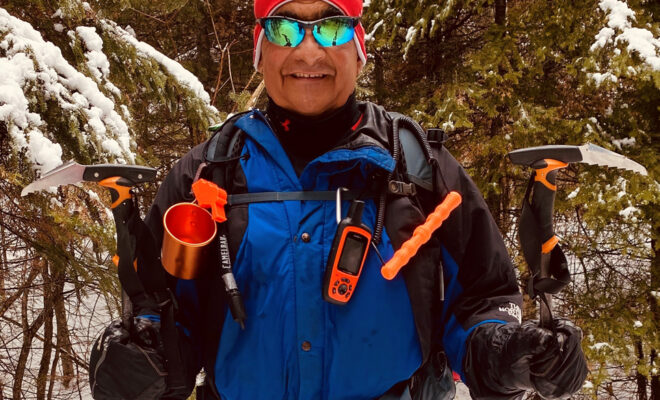Winter Cycling and Ski/Snowshoe Dressing Guide

George Pastorino
President & Mountain Bike Coordinator- Elmhurst Bike Club
[email protected]
Still in time for your Christmas shopping, as well as your safety(!), this is a winter dress guide for cyclists, skiers, and other outdoor enthusiasts, And, it has been battle-tested by my wife, Pussanee, and I. We both hate to be cold and, at 95 pounds, she has a scant amount of body fat to insulate her.
While the following examples work for Pussanee and me, many good ways exist to stay warm riding all year. Everyone has a different internal thermostat and cold tolerance, but this article will give you a good general starting point.
Most of these tips also work well for Snowshoeing and XC skiing. We have been outside for 7 hours in 30- below-zero temps without being cold. We even went mountain biking in the Polar Vortex during a 55-below zero wind chill and experienced no problems, it’s really just a matter of being prepared with the correct clothing and gear along with a sunny mindset.
Legs & Torso
Most people over-dress for cold weather excursions. Down to about 10 degrees, we wear a thin smart wool top and bottom under a breathable windproof jacket and windproof tights. Below 10, we add a thin, synthetic long underwear layer under the smart wool. This arrangement takes us all the way below zero. Don’t forget, you’re exercising, not ice fishing; dressing too warm is a killer.
It takes a little tinkering to find the best combination for each person and weather condition. Most of the winter, we wear thin synthetic long underwear under our windproof tights as legs prove easier to keep warm.
Start out cold and carry layers in your pack. Put them on if you don’t warm up. Don’t think you can start warm and shed layers. This doesn’t work as you will get sweaty. Also, you don’t need battery- operated electric clothing of any kind. That is for sitting and watching an outdoor football game. As you ride, ski, or snowshoe, you will generate heat.
What’s Best for Hands
Keeping hands warm present a big problem for most people. It can be overcome. In my experience, five-finger gloves are not very effective below 30 degrees. From about 20 to 35 degrees, we use good quality heavy Lobsters (gloves with shaped as large 2 “fingers” and a thumb). See Example here: (Gift Guide Link ⇒) Lobster Gloves.
Below 20 degrees, I have found the best way to keep your hands warm comes from wearing a good quality mitten with a hand warmer inside. You can spend $300.00 on five-finger-shaped gloves and your hands can still freeze because these gloves separate your fingers, thus their warming abilities, from each other. Glove liners don’t help because they further isolate the fingers from each other.
Mittens provide your ticket to happy winter cycling and, yes, you can shift fine, road STI or mountain. We have tested many, but like this one the most: (Gift Guide Link ⇒) Alti Mitts. It’s a fact: Mittens prove warmer than gloves, backed by much empirical scientific evidence, research, and field experience. Physics dictates that mittens must be warmer than gloves made of the same material.
Gloves put more surface area in contact with cold air than mittens do. Therefore, they cannot keep your hands as warm with the same amount of insulation. What’s more, gloves force each finger to fend for itself. In a mitten, fingers contact each other directly and share the heat in one insulated space.
Read the first paragraph of this article here: (Gift Guide Link ⇒) Mittens are warmer. See article here: (Gift Guide Link ⇒) When it’s too cold for gloves.
You can also use Bar Mitts, like this one from 45 North: (Gift Guide Link ⇒) CobraFist. With these you can just wear a light glove or glove liner. My hands get cold easily so I use these: (Gift Guide Link ⇒) Expedition Pogies. They are the warmest made.
Up Next: Keeping Tootsies Toasty
There are a few good solutions for the feet without investing tons of money. Shoe covers with chemical hand or toe warmers may work down to about 20 degrees, but are not ideal. If you want to give up your clipless pedals, you can wear warm hiking boots.
Pussanee and I use aggressive flat pedals like these for mountain biking all year long and on the road in winter: (Gift Guide Link ⇒) Thin, aggressive Flat Pedals. If you don’t clip in like us, you can use a good winter hiking boot. We really like these: (Gift Guide Link ⇒) SNOWBURBAN II ULTRADRY.
We augment our warm hiking boots with Gaiters. Some think Gaiters are only useful for deep snow. I learned their warmth function in my Mountain Climbing training. Heat escapes up and out from the cuff of your boot, allowing your feet to get cold. Gaiters seal the cuff completely, making whatever boot you wear much warmer. We wear them all the time when it’s cold, not just when we think we will encounter deep snow. We really like this one: (Gift Guide Link ⇒) EXPEDITION CROCODILE GAITERS.
Here are two robust boots for clip-less pedals from 45 North: (Gift Guide Link ⇒) WÖLVHAMMER. If you really get cold feet, and feel you must clip in and can afford it, then buy this: (Gift Guide Link ⇒) WØLFGAR. They are the warmest boot for clips. Make sure your winter boots are not tight. Go at least one size larger than normal as you need room for thicker socks. If your boots are tight, your feet will freeze.
Socks are important and Alpaca makes the warmest, much warmer than our heaviest Smart Wool sock. They’re sinfully soft and insulate while wet. This is one we wear: (Gift Guide Link ⇒) Alpaca Socks. While on the subject of socks, don’t wear two pair or sock liners. One pair of warm socks is all you need.
Warm Head, Warm Heart
Also, in cold weather (below 20), we wear downhill ski helmets and ski goggles. Helmets are light, warm, and completely cover your ears. Ski goggles, also light, cover your eyes in a way that allows the air to warm around them, avoiding cornea freeze. Add a balaclava to keep your face warm.
Ski helmets and goggles work better while MTB riding in the woods. Road riding while wearing this gear could cause problems with seeing cars due to peripheral vision issues. We really love this helmet: (Gift Guide Link ⇒) Smith Vantage Helmet MIPS. Any Ski Goggle with double lenses will work just fine.
I would like to share a product Pussanee and I use on our face and other exposed skin while being active outdoors in winter to prevent wind burn and frostbite: Dermatome. This frostbite fighter provides great skin protection. Info here: (Gift Guide Link ⇒) Dermatone Frostbite Fighter.
This video was taken during a minus 45degree wind-chill, with the volume turned up to hear the wind. Pussanee was never cold:
Remember: The weather is never bad; people fail to dress appropriately for it. Are you outside all winter? You could be, and comfortable at all times, the entire time.
Thank you, from – George Pastorino
President & Mountain Bike Coordinator- Elmhurst Bike Club
Graduate Winter Wilderness Survival School
Wilderness First Aid Certified
National Mountain Bike Patrol Instructor
Certified Mountain Bike Guide
Accredited Bike Medic
CPR, AED and Life Support Graduate




